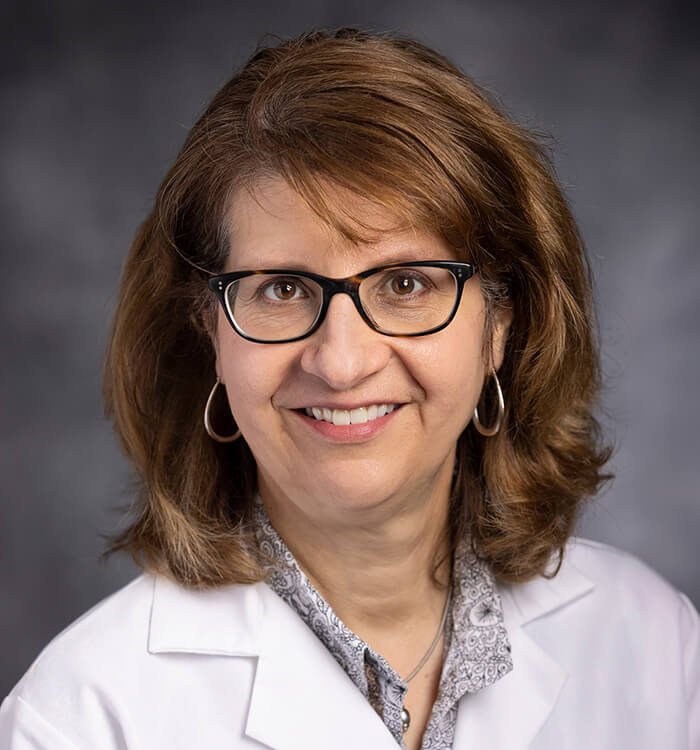Targeting Stigma and Hesitancy to Participate in Research Among Patients with Neurological Disorders
February 15, 2023
Innovations in Neurology & Neurosurgery | Winter 2023
Martha Sajatovic, MD, director of the Neurological and Behavioral Outcomes Center at University Hospitals Cleveland Medical Center, is conducting novel studies of stigma and research participation hesitancy that affect individuals with neurological disorders.
 Martha Sajatovic, MD
Martha Sajatovic, MD“This is something I have been working on for a long time, reaching out to people who are too often underrepresented in research because of hesitancy or fear. If you understand the process of stigma and the mechanism of action from a scientific basis, you can search for ways to address it,” says Dr. Sajatovic, the Willard Brown Chair in Neurological Outcomes and Rocco L. Motto Professor in Child & Adolescent Psychiatry at University Hospitals. “Our goal is to reduce some of the human burden and suffering associated with stigma and isolation so that people feel more empowered to get help for their conditions and participate in research that will lead to better treatments and cures.”
Last November, Dr. Sajatovic presented her findings at the Neurosurgeon Research Career Development Program (NRCDP) in Park City, Utah. Her work focused on two neurological conditions: epilepsy and Alzheimer’s disease (AD).
Investigating and Targeting Epilepsy Stigma
After a literature review of epilepsy stigma research over the past decade, Dr. Sajatovic and her team developed a randomized control trial of two experimental videos. The study, funded through a U.S. Centers for Disease Control and Prevention (CDC) grant, recruited 300 local and online participants ages 18 to 29. With input from a community advisory board, the team created two live-action videos aimed at reducing public epilepsy stigma. The control arm was a standard public service announcement.
“One video focused on social inclusion and having the courage to be friendly to people with epilepsy,” says Dr. Sajatovic. “The other conveyed that we are all different and the importance of accepting one another’s differences.” Standardized rating scales administered after viewing each video measured participants ‘knowledge and attitudes toward epilepsy. “While we will continue to refine our message and delivery approaches, we identified some key takeaways to reduce epilepsy stigma,” says Dr. Sajatovic. They include:
- Keeping educational messaging brief (less than five minutes)
- Ensuring that messengers are credible and relatable
- Harnessing web aggregation sites (i.e., Buzzfeed, Reddit) to quickly upscale delivery
- Targeting high-risk subgroups and young adults for lasting impact
Reducing Stigma and Research Hesitancy in Alzheimer’s Disease (AD)
Prevalence of AD is a growing concern in the United States. Currently, one in nine people ages 65 and older has AD. Dr. Sajatovic identified factors that seem to drive AD stigma and studied their effects on people coping with cognitive loss. They include:
- Hiding an AD diagnosis from others
- Avoiding treatment
- Withdrawing socially or overdepending on family
- Increasing caregiver isolation and burden
- Diminished quality of life
Using the trans-theoretical conceptual model of change, the research team developed the POWER project to boost awareness among underserved minority groups about participating in AD research. The three-phase project started by using an existing minority advisory board of the Cleveland Alzheimer’s Disease Research Center (CADRC) to create AD-focused health education videos.
“Our purpose was to communicate with people about participating in AD research and to try to minimize some of the barriers,” says Dr. Sajatovic. “We tested the effects of the videos and are working to analyze and report the results.” Some early takeaways to reducing AD stigma include:
- Educating the public at every age
- Increasing support to individuals diagnosed with early stage AD
- Stressing the variability of progression
- Reducing isolation of the person with AD through memory groups or social contact
- Giving people with AD a voice by speaking to them directly versus to a care partner
- Recognizing the rights of individuals with AD to participate in healthcare and life decisions
- Acknowledging that AD stigma can be unintentional
- Calling attention to and criticizing media stigma of AD
Building Bridges
Dr. Sajatovic emphasizes that advancing medical research requires collaboration between patients, families and the community. “Doctors and scientists have to work in partnership with people coping with neurological conditions,” she says. “When there is engagement on both sides, we can help patients feel motivated and empowered that their willingness to get involved in research and advancing knowledge can make a lasting difference.”
For more information, contact Dr. Sajatovic at Martha.Sajatovic@UHhospitals.org.
Contributing Expert:
Martha Sajatovic, MD
Director of the Neurological and Behavioral Outcomes Center
Willard Brown Chair in Neurological Outcomes
Rocco L. Motto Professor in Child & Adolescent Psychiatry
University Hospitals Cleveland Medical Center
Professor of Psychiatry and Neurology
Case Western Reserve University School of Medicine


